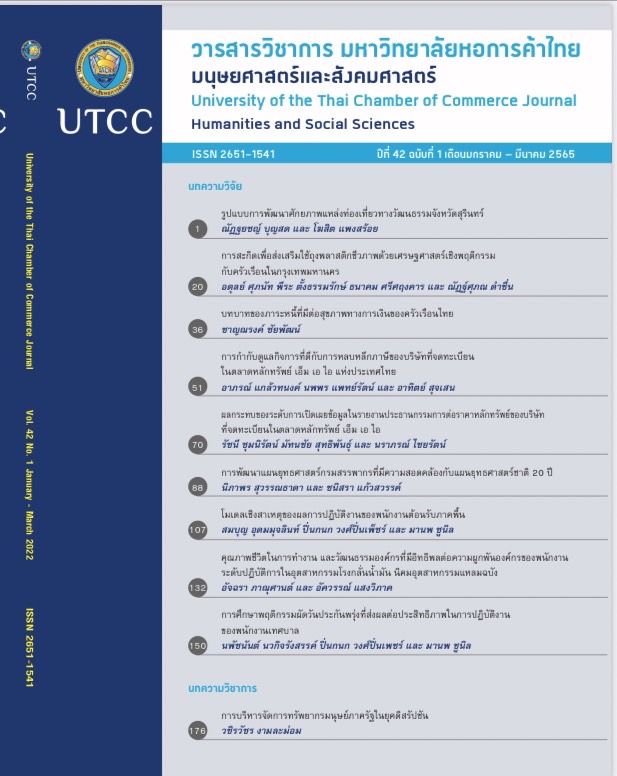The Role of Debt in Financial Health of Thai Households
Main Article Content
Abstract
Household debt in Thailand has been expanded rapidly to 79.90% per GDP. What does the economic facet of Thai households look like? Are they happily ready to become the elderly? This study aimed to analyse situations regarding debt and financial health, then examine the impacts of debt on the financial health of households in Thailand using the Household Socio-Economic Survey (SES) in 2019. The result showed that most Thai household debt (40%) was consumer debt, while 29.85% of the household debt was caused by purchasing a property. It also revealed that 26.78% of the senior population had financial wellbeing, 44.32 % had their financial health at risk, and 2.89% had critical financial health. When analysing the role of debt, it was found that households with debt caused by purchasing property were likely to have better financial health. In contrast, households with consumer debt were likely to have more critical financial health. It showed that Thai households have very high consumer debt. Therefore, to solve debt problems, Thai households should hurriedly reduce the proportion of consumer debt. A financial health check is one way to help adjust their financial behaviour with an aim to increase the number of households with sound financial health and well-prepared wellbeing senior citizens who wouldn’t cause financial burdens to others.
Article Details

This work is licensed under a Creative Commons Attribution-NonCommercial-NoDerivatives 4.0 International License.
ลิขสิทธิ์ของบทความ
ผลงานที่ได้รับการตีพิมพ์ถือเป็นลิขสิทธิ์ของมหาวิทยาลัยหอการค้าไทย ห้ามมิให้นำเนื้อหา ทัศนะ หรือข้อคิดเห็นใด ๆ ของผลงานไปทำซ้ำ ดัดแปลง หรือเผยแพร่ ไม่ว่าทั้งหมดหรือบางส่วนโดยไม่ได้รับอนุญาตเป็นลายลักษณ์อักษรจากมหาวิทยาลัยหอการค้าไทยก่อน
References
กองทุนบำเหน็จบำนาญข้าราชการ. (2548). เกร็ดการออม (พิมพ์ครั้งที่ 3). สืบค้นจาก http://www.pssgroup.moi.go.th/pdf/save/save.pdf
ธนาคารแห่งประเทศไทย. (2563). สถิติเศรษฐกิจการเงิน. สืบค้นเมื่อ 12 ธันวาคม 2563, จาก https://www.bot.or.th/Thai/Statistics/EconomicAndFinancial/Pages/default.aspx
ธนาคารแห่งประเทศไทย, ฝ่ายนโยบายการเงิน. (2562, ธันวาคม). โครงสร้างหนี้ครัวเรือนไทยและนัยต่อฐานะการเงินภาคครัวเรือนไทย. รายงานนโยบายการเงิน, 20-21.
ปฐมาภรณ์ นิธิชัย. (2556, ตุลาคม). วิเคราะห์พอร์ตการลงทุนของมนุษย์เงินเดือนวัยก่อนเกษียณกับการเพิ่มโอกาสเกษียณสุข. Research Note, ฉบับที่ 4/2556, 1-9.
พรอนงค์ บุษราตระกูล, รุ่งเกียรติ รัตนบานชื่น, รัฐชัย ศีลาเจริญ, ณรงค์ฤทธิ์ อัศวเรืองพิภพ, อนิรุต พิเสฎฐศลาศัย, สุนทรี เหล่าพัดจัน, ...สิทธิเดช บำรุงทรัพย์. (2559). โครงการศึกษาวิเคราะห์ระดับสินทรัพย์การออมขั้นต่ำที่ผู้เกษียณอายุพึงมีสำหรับการประกันคุณภาพชีวิตขั้นพื้นฐาน (วัยสูงอายุ). กรุงเทพฯ: มหาวิทยาลัยเกษตรศาสตร์ วิทยาเขตศรีราชา, คณะวิทยาการจัดการ และจุฬาลงกรณ์มหาวิทยาลัย, คณะพาณิชยศาสตร์และการบัญชี.
พระครูสิริปริยัติธํารง. (2554). ศึกษาวิเคราะห์เปรียบเทียบโภควิภาค 4 กับปรัชญาเศรษฐกิจพอเพียง. (วิทยานิพนธ์ปริญญามหาบัณฑิต ไม่ได้ตีพิมพ์). มหาวิทยาลัยมหาจุฬาลงกรณราชวิทยาลัย, พระนครศรีอยุธยา.
มนต์ทนา คงแก้ว, ชฎามาศ แก้วสุกใส, และนัดพลพิชัย ดุลยวาฑิต. (2557). การบริหารการเงินส่วนบุคคลเพื่อสู่อิสรภาพทางการเงินของข้าราชการใน 4 จังหวัดชายแดนภาคใต้. สงขลา: มหาวิทยาลัยเทคโนโลยีราชมงคลศรีวิชัย.
สถาบันพัฒนาความรู้ตลาดทุน. (2552). ความรู้เบื้องต้นเกี่ยวกับการวางแผนการเงิน. กรุงเทพฯ: ตลาดหลักทรัพย์แห่งประเทศไทย.
สถาบันวิจัยเพื่อการประเมินและออกแบบนโยบาย. (2556). การเตรียมความพร้อมสำหรับการวางแผนทางการเงินเพื่อวัยเกษียณของกลุ่มแรงงานในระบบ ช่วงอายุ 40-60 ปี. กรุงเทพฯ: ตลาดหลักทรัพย์แห่งประเทศไทย.
สำนักงานสถิติแห่งชาติ. (2563). การสำรวจทางเศรษฐกิจและสังคมของครัวเรือน ปี พ.ศ. 2562. สืบค้นเมื่อ 8 ธันวาคม 2563, จาก http://statbbi.nso.go.th/staticreport/page/sector/th/08.aspx
โสมรัศมิ์ จันทรัตน์, อัจจนา ล่ำซำ, กฤษฎ์เลิศ สัมพันธารักษ์, และภูมิใจ ตั้งสวัสดิรัตน์. (2562). เข้าใจพลวัตหนี้ครัวเรือนไทยผ่าน Big data ของเครดิตบูโร. สืบค้นเมื่อ 13 มิถุนายน 2564, จาก https://www.pier.or.th/?abridged=เข้าใจพลวัตหนี้ครัวเรือน
อัจฉรา โยมสินธุ์. (2560). 40+ยังไม่สาย เกษียณสบายเป็นจริงได้. กรุงเทพฯ: ตลาดหลักทรัพย์แห่งประเทศไทย, ศูนย์ส่งเสริมการพัฒนาความรู้ตลาดทุน.
Altfest, L. J. (2007). Personal financial planning. New York, NY: McGraw-Hill.
Mauriello, C. (2001). Net worth (Chapter 13- Good debt: Mortgage debt). Retrieved from https://www.sciencedirect.com/science/article/pii/B9781884133831500149
Moon, S. J., Yuh, Y., & Hana, S. D. (2002). Financial ratio analysis of Korean household. Family and Consumer Sciences Research Journal, 30(4), 495-525.
Shipley, J. (2011). 10 steps to financial freedom in your twenties and thirties. Retrieved from https://www.yumpu.com/en/document/view/21546065/10-steps-to-financial-freedom-in-your-twenties-and-genspring
United Nations, Population division. (2019). World population prospects 2019.Retrieved June 13, 2021, from https://population.un.org/wpp/
The World Bank. (2020). GDP growth - Thailand. Retrieved from https://data.worldbank.org/indicator/NY.GDP.MKTP.KD.ZG?locations=TH


